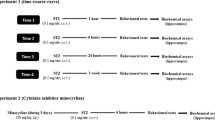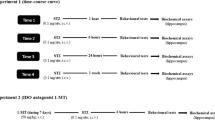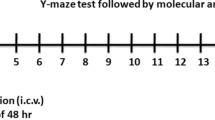Abstract
Neuroinflammation and mitochondrial dysfunction are suggested as mechanisms which are implicated in the pathophysiology of depression. Streptozotocin (STZ) is known to produce immune-inflammatory responses and mitochondrial dysfunction in different types of animal models of disease (e.g. type-1 diabetes and Alzheimer’s disease). Therefore, a single low dose of Streptozotocin (STZ; intracerebroventricular, i.c.v, 0.2 mg/mouse) was used to induce an animal model of depression. The present study aims to investigate the effects of short (24 h) and long (14 days) exposure to minocycline on STZ-induced depressive-like behaviors (n = 6–8), hippocampal oxidative state biomarkers (n = 4), and the expression of hippocampal genes related to innate immunity (n = 3) in the hippocampus of male adult mice. In addition, the protective effects of different modes of minocycline (acute pretreatment (20 mg/kg, 1 h before STZ), acute post-treatment (20 mg/kg, 24 h after STZ), chronic pretreatment (5 mg/kg/day for 14 days before STZ), and chronic post-treatment (5 mg/kg/day for 14 days after STZ) were compared with the STZ effects. As the data showed, both short and long effects of STZ were associated with the depressive-like behaviors, abnormal mitochondrial function, and upregulation of neuroinflammatory genes in the hippocampus. Different modes of minocycline treatment could attenuate the negative impact of STZ on animals. The data suggested that minocycline at a human therapeutic dose (5 mg/kg) had protective effects against acute cellular damage induced by oxidation and the consequent inflammatory responses.




Similar content being viewed by others
References
WHO (2017) Depression and other common mental disorders: global health estimates. WHO, Geneva
Maes M (1995) Evidence for an immune response in major depression: a review and hypothesis. Prog Neuropsychopharmacol Biol Psychiatry 19(1):11–38
Gardner A, Boles RG (2011) Beyond the serotonin hypothesis: mitochondria, inflammation and neurodegeneration in major depression and affective spectrum disorders. Prog Neuropsychopharmacol Biol Psychiatry 35(3):730–743
Franklin TC, Xu C, Duman RS (2018) Depression and sterile inflammation: essential role of danger associated molecular patterns. Brain Behav Immun 72:2–13
Moylan S, Berk M, Dean OM, Samuni Y, Williams LJ, O’neil A, Hayley AC, Pasco JA, Anderson G, Jacka FN (2014) Oxidative & nitrosative stress in depression: why so much stress? Neurosci Biobehav Rev 45:46–62
Sonei N, Amiri S, Jafarian I, Anoush M, Rahimi-Balaei M, Bergen H, Haj-Mirzaian A, Hosseini M-J (2017) Mitochondrial dysfunction bridges negative affective disorders and cardiomyopathy in socially isolated rats: pros and cons of fluoxetine. World J Biol Psychiatry 18(1):39–53
Bansal Y, Kuhad A (2016) Mitochondrial dysfunction in depression. Curr Neuropharmacol 14(6):610–618
López-Armada MJ, Riveiro-Naveira RR, Vaamonde-García C, Valcárcel-Ares MN (2013) Mitochondrial dysfunction and the inflammatory response. Mitochondrion 13(2):106–118
Salminen A, Ojala J, Kaarniranta K, Kauppinen A (2012) Mitochondrial dysfunction and oxidative stress activate inflammasomes: impact on the aging process and age-related diseases. Cell Mol Life Sci 69(18):2999–3013
Zhou R, Yazdi AS, Menu P, Tschopp J (2011) A role for mitochondria in NLRP3 inflammasome activation. Nature 469(7329):221
Amiri S, Haj-Mirzaian A, Momeny M, Amini-Khoei H, Rahimi-Balaei M, Poursaman S, Rastegar M, Nikoui V, Mokhtari T, Ghazi-Khansari M (2017) Streptozotocin induced oxidative stress, innate immune system responses and behavioral abnormalities in male mice. Neuroscience 340:373–383
Garrido-Mesa N, Zarzuelo A, Gálvez J (2013) Minocycline: far beyond an antibiotic. Br J Pharmacol 169(2):337–352
Kim H-S, Suh Y-H (2009) Minocycline and neurodegenerative diseases. Behav Brain Res 196(2):168–179
Haley T, McCormick W (1957) Pharmacological effects produced by intracerebral injection of drugs in the conscious mouse. Br J Pharmacol Chemother 12(1):12–15
Abraham J, Fox PD, Condello C, Bartolini A, Koh S (2012) Minocycline attenuates microglia activation and blocks the long-term epileptogenic effects of early-life seizures. Neurobiol Dis 46(2):425–430
Stack EC, Smith KM, Ryu H, Cormier K, Chen M, Hagerty SW, Del Signore SJ, Cudkowicz ME, Friedlander RM, Ferrante RJ (2006) Combination therapy using minocycline and coenzyme Q10 in R6/2 transgenic Huntington’s disease mice. Biochim et Biophys Acta (BBA) Mol Basis Dis 1762(3):373–380
Cryan JF, Markou A, Lucki I (2002) Assessing antidepressant activity in rodents: recent developments and future needs. Trends Pharmacol Sci 23(5):238–245
Ducottet C, Belzung C (2004) Behaviour in the elevated plus-maze predicts coping after subchronic mild stress in mice. Physiol Behav 81(3):417–426
Kulesskaya N, Voikar V (2014) Assessment of mouse anxiety-like behavior in the light–dark box and open-field arena: role of equipment and procedure. Physiol Behav 133:30–38
Haj-Mirzaian A, Amiri S, Amini-Khoei H, Rahimi-Balaei M, Kordjazy N, Olson CO, Rastegar M, Naserzadeh P, Marzban H, Dehpour AR (2016) Attenuation of oxidative and nitrosative stress in cortical area associates with antidepressant-like effects of tropisetron in male mice following social isolation stress. Brain Res Bull 124:150–163
Bradford MM (1976) A rapid and sensitive method for the quantitation of microgram quantities of protein utilizing the principle of protein-dye binding. Anal Biochem 72(1–2):248–254
Amiri S, Yousefi-Ahmadipour A, Hosseini M-J, Haj-Mirzaian A, Momeny M, Hosseini-Chegeni H, Mokhtari T, Kharrazi S, Hassanzadeh G, Amini SM (2018) Maternal exposure to silver nanoparticles are associated with behavioral abnormalities in adulthood: role of mitochondria and innate immunity in developmental toxicity. NeuroToxicology 66:66–77
Amiri S, Amini-Khoei H, Haj-Mirzaian A, Rahimi-Balaei M, Naserzadeh P, Dehpour A, Mehr SE (1850) Hosseini M-J (2015) Tropisetron attenuated the anxiogenic effects of social isolation by modulating nitrergic system and mitochondrial function. Biochimica et Biophysica Acta (BBA) 12:2464–2475
Maes M (2008) The cytokine hypothesis of depression: inflammation, oxidative & nitrosative stress (IO&NS) and leaky gut as new targets for adjunctive treatments in depression. Neuro Endocrinol Lett 29(3):287–291
Raison CL, Capuron L, Miller AH (2006) Cytokines sing the blues: inflammation and the pathogenesis of depression. Trends Immunol 27(1):24–31
Hodes GE, Ménard C, Russo SJ (2016) Integrating Interleukin-6 into depression diagnosis and treatment. Neurobiol Stress 4:15–22
Rizzo SS, Neal S, Hughes Z, Beyna M, Rosenzweig-Lipson S, Moss S, Brandon N (2012) Evidence for sustained elevation of IL-6 in the CNS as a key contributor of depressive-like phenotypes. Transl Psychiatry 2(12):e199
Solmi M, Veronese N, Thapa N, Facchini S, Stubbs B, Fornaro M, Carvalho AF, Correll CU (2017) Systematic review and meta-analysis of the efficacy and safety of minocycline in schizophrenia. CNS Spectr 22(5):415–426
Malhotra K, Chang JJ, Khunger A, Blacker D, Switzer JA, Goyal N, Hernandez AV, Pasupuleti V, Alexandrov AV, Tsivgoulis G (2018) Minocycline for acute stroke treatment: a systematic review and meta-analysis of randomized clinical trials. J Neurol 265(8):1871–1879
Reis DJ, Casteen EJ, Ilardi SS (2019) The antidepressant impact of minocycline in rodents: a systematic review and meta-analysis. Sci Rep 9(1):261
Souza LC, Jesse CR, de Gomes MG, Viana CE, Mattos E, Silva NC, Boeira SP (2017) Intracerebroventricular administration of streptozotocin as an experimental approach to depression: evidence for the involvement of proinflammatory cytokines and indoleamine-2, 3-dioxygenase. Neurotox Res 31(4):464–477
Bădescu S, Tătaru C, Kobylinska L, Georgescu E, Zahiu D, Zăgrean A, Zăgrean L (2016) The association between diabetes mellitus and depression. J Med Life 9(2):120
Anderson RJ, Freedland KE, Clouse RE, Lustman PJ (2001) The prevalence of comorbid depression in adults with diabetes: a meta-analysis. Diabetes Care 24(6):1069–1078
Arvanitakis Z, Wilson RS, Bienias JL, Evans DA, Bennett DA (2004) Diabetes mellitus and risk of Alzheimer disease and decline in cognitive function. Arch Neurol 61(5):661–666
Katon WJ, Lin EH, Williams LH, Ciechanowski P, Heckbert SR, Ludman E, Rutter C, Crane PK, Oliver M, Von Korff M (2010) Comorbid depression is associated with an increased risk of dementia diagnosis in patients with diabetes: a prospective cohort study. J Gen Intern Med 25(5):423–429
De Felice FG, Ferreira ST (2014) Inflammation, defective insulin signaling, and mitochondrial dysfunction as common molecular denominators connecting type 2 diabetes to Alzheimer disease. Diabetes 63(7):2262–2272
Bhatt LK, Addepalli V (2010) Attenuation of diabetic retinopathy by enhanced inhibition of MMP-2 and MMP-9 using aspirin and minocycline in streptozotocin-diabetic rats. Am J Transl Res 2(2):181
Ali S, Driscoll HE, Newton VL, Gardiner NJ (2014) Matrix metalloproteinase-2 is downregulated in sciatic nerve by streptozotocin induced diabetes and/or treatment with minocycline: implications for nerve regeneration. Exp Neurol 261:654–665
Pabreja K, Dua K, Sharma S, Padi SS, Kulkarni SK (2011) Minocycline attenuates the development of diabetic neuropathic pain: possible anti-inflammatory and anti-oxidant mechanisms. Eur J Pharmacol 661(1–3):15–21
Mejia ROS, Ona VO, Li M, Friedlander RM (2001) Minocycline reduces traumatic brain injury-mediated caspase-1 activation, tissue damage, and neurological dysfunction. Neurosurgery 48(6):1393–1401
Homsi S, Piaggio T, Croci N, Noble F, Plotkine M, Marchand-Leroux C, Jafarian-Tehrani M (2010) Blockade of acute microglial activation by minocycline promotes neuroprotection and reduces locomotor hyperactivity after closed head injury in mice: a twelve-week follow-up study. J Neurotrauma 27(5):911–921
Funding
This work was supported by the deputy of research of Zanjan University of Medical Sciences (Grant No. A-12-769-16 &29).
Author information
Authors and Affiliations
Contributions
Conceived and designed the experiments and the study protocol: MJH & SEM; Performed the experiments: HM, SA, MM & SB; Analyzed the data: MJH, SA & HAK; Interpretation of the data: MJH & SEM; Wrote the paper: MJH, SA & SEM. Critical review of the manuscript: MJH, SA & SEM.
Corresponding author
Ethics declarations
Conflict of interest
All authors declare that they have no conflict of interest.
Informed consent
Informed consent was obtained from all individual participants included in the study.
Research involving human participants and/or animals
All procedures were performed in line with the NIH Guide for the Care and Use of Laboratory Animals, which were approved by the Animal Ethics committee of Zanjan University of Medical Sciences (registration number: ZUMS.REC.1394.244).
Additional information
Publisher's Note
Springer Nature remains neutral with regard to jurisdictional claims in published maps and institutional affiliations.
Rights and permissions
About this article
Cite this article
Mozafari, H., Amiri, S., Mehr, S.E. et al. Minocycline attenuates depressive-like behaviors in mice treated with the low dose of intracerebroventricular streptozotocin; the role of mitochondrial function and neuroinflammation. Mol Biol Rep 47, 6143–6153 (2020). https://doi.org/10.1007/s11033-020-05696-w
Received:
Accepted:
Published:
Issue Date:
DOI: https://doi.org/10.1007/s11033-020-05696-w




